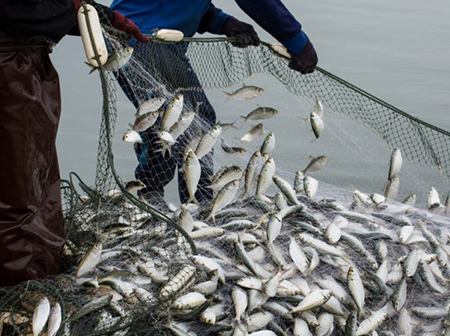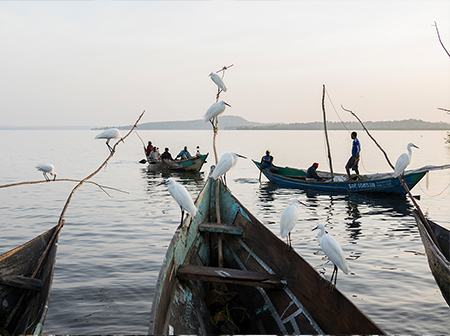Fishing industry
1. Economic role of fishing
The fishing industry is the most important source of animal protein in the diet of the Cameroonian population. Annual per capita consumption is estimated between 13.6 kg and 19 kg, representing an intake of around 42.3% of animal protein and covering 9.5% of total needs. Fish are generally the most consumed source of animal protein by the economically weakest segments of the population.
According to data collected from the Ministry of Livestock, Fisheries and Animal Industries (Minepia), during the first ten months of 2019, estimates of fishery production in Cameroon are around 289,764 tonnes. In detail, 271,317 tonnes of fish are recorded for artisanal fishing, 11,370 tonnes of fish for industrial fishing and 7,077 tonnes of fish for aquaculture.

To boost this production, Minepia claims to have finalized the procedures for building a modern fish market at Youpwé in Douala. The actual start of field work is scheduled for 2020. In addition, three new ice production units in Douala, Limbe and Idenau have been acquired to improve the reduction of post-harvest losses.
The number of fishermen is currently estimated at around 20,000 for artisanal maritime fishing, and 40,000 for inland fishing. It is estimated that the number of direct fishing jobs in Cameroon is around 60,000 while nearly 180,000 people are engaged in secondary fishing activities (processing, storage, distribution, and fish trade. ). Among the number of jobs provided by fishing in Cameroon, it is estimated that around 80% are occupied by expatriates, mainly from Nigeria.
2. Zones de pêche
a) Pêche maritime
Cameroonian maritime waters are located in the western pocket of the Gulf of Guinea, in a so-called equatorial calm zone of the Atlantic Ocean. The seafront stretches for nearly 360 km while the average width of this area is only about 40 km, given the proximity to the coast.
Cameroon identifies a hydrographic network comprising several river systems. The mouths of these rivers are very popular fishing grounds for catching estuarine shrimp, coastal pelagic fish and demersal species. In these areas, fishing conditions are not marked by any seasonality in terms of temperature, salinity or surface water thickness.
b) Pêche continentale
Inland fishing in Cameroon can be divided into three distinct zones: the forest zone, the central region and the northern region. Continental waters, at their average annual level, have a total area estimated at 35,000 km 2 , or about 7.4% of the national territory. The approximate distribution is as follows: floodplains and marshes 86%; natural lakes 4%; dam retention 7%; rivers 3%.
– Zone forestière
This zone includes three important river basins: Nyong, Ntem, Sangha (with Dja). The first two are coastal rivers while the Sangha is a tributary of the Congo.
– Central area (Sanaga basin).
This area mainly includes the Sanaga River and its tributaries as well as some minor coastal basins (Wouri, Cross) to the west. The Sanaga river and its tributaries constitute an important hydrographic network by their volume, which can reach nearly 6,000 m3 / s depending on the season.
– Northern region
The northern region is home to Cameroon’s largest inland fisheries, which account for over 70% of national production in inland waters. This region includes the basins of Faro, Bénoué (with the Lagdo reservoir), Logone-Chari, the Yaéré and the Maga reservoir, Lake Chad and, finally, the small dams located in the Mandara mountains (around Mokolo). There are, however, three types of fisheries: Lake Chad; rivers and flood plains; large reservoirs (Maga and Lagdo).
c) Zone de mangroves
Cameroonian mangroves cover an area of approximately 5,000 km 2 , or 1% of the national territory. They are mainly found in the two large deltaic areas of the coast, that of Isanguele in the north and that of Douala in the center, as well as at the mouth of the Ntem in the extreme south. They constitute a particular aquatic ecosystem, of brackish environment (average salinities between 7 and 12%), which is at the base of the marine halieutic wealth of the country.
d) Maritime industrial fishing
The real development of industrial fishing began in the 1970s. In 1972, 42 industrial boats had been identified, mainly geared towards shrimp fishing. From 1973, the yields of this fishery having fallen, the shrimp boats converted to fish fishing.
The number of trawlers has decreased over the last decade from 17 vessels in 1979 to 6 vessels in 1991. This reduction has been accompanied by an aging of the fleet from an average age of 7.31 years in 1979 to 11. years in 1991.
The current situation of the industrial fleet is as follows: eight shipping lines manage 35 vessels, including six trawlers and 29 shrimpers. As of January 1, 2020, six companies were granted authorization.
e) Pêche artisanale maritime
– Les embarcations

The single canoe : it is formed from a single piece cut from a tree trunk.
La pirogue monoxyle rehaussée de planches : it differs from the previous one by the presence of a plating which slightly increases the width and the depth and above all protects the hull from wear resulting from friction from fishing gear, ropes, etc.
The Nigerian canoe: it is made entirely of planks, generally rectangular in shape at the sides, and triangular at the ends. The pieces of wood are joined by innumerable nails whose lines can be seen on the sides.
The Ghanaian “watsha” canoe: imported from Ghana, the Ghanaian canoe is a large monoxyl boat (12 m on average) surmounted by a plank.
The Nigerian canoe “Watsha”: it is the all-plank version of the Ghanaian canoe with the possibility, for this type of construction, of making large boats, up to 18 m long by 3 m wide and 1.50 m deep.
Bekumu’s shrimp fishing canoe: it is usually built in planks but some units have a fairly large monoxyle base on which its tails are mounted.
– Fishing gear
Artisanal fishing units use fishing gear that is extremely diverse. The gear most used by artisanal fishing are gillnets, set, drift, or encircling, as well as small conical shrimp nets used especially in the Ndian and Fako.
The supply is done through MIDEPECAM which has 5 branches located in different coastal departments, supplemented by repair shops for outboard motors. The material marketed by MIDEPECAM is of good quality and easily accessible.
